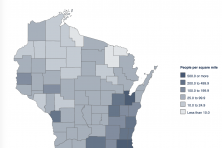County Grows 4 Percent in Land Valuation
- Share
- Tweet
- Pin
- Share
Disparities remain among communities
The value of Door County’s land is 4 percent higher than last year – a $7.5 billion increase – according to new preliminary estimates from the Department of Revenue. The report describes changes in equalized value – or the total value of all the land, buildings and some personal property – for each municipality for tax purposes from 2018 to 2019.
Countywide, the bulk of the gain was made through economic change, or the increase in value due to market demand instead of new buildings. Higher demand for existing residential property increased the value of homes by $188.4 million, or 3 percent. Existing commercial properties also had a 3 percent gain, adding $24.4 million in value.
The county saw modest increases in new construction as well. The total value of new houses built in 2018 was $71.1 million, a 1 percent increase. Meanwhile, new commercial buildings added $14.3 million in new value, a 2 percent increase. The relatively faster growth of new commercial construction may indicate that business owners are responding to a boom in new residential construction that took place in previous years.
Most local government leaders closely watch the growth in net new construction because of a state law limiting tax-levy increases to the growth in new construction. Essentially, if there are no new buildings built in a county or municipality, that local government cannot increase the tax levy.
The state implemented this policy in 2011 to restrict local governments from increasing property taxes, but rising costs in communities that have not seen any new construction are straining some budgets. Gov. Tony Evers proposed allowing a 2 percent increase in the levy limit, regardless of new construction, but that did not make it through the 2019-21 budget process, meaning that levy limits tied to new construction are still in place.
Although the county as a whole grew at 4 percent, there are disparities among municipalities. Generally, communities in Southern Door grew at slower rates than those in Northern Door.
The Town of Egg Harbor saw the fastest growth, with a 10 percent increase in valuation from 2018. The bulk of this gain was due to economic change – or greater demand for the land in Egg Harbor, which grew 7 percent. There was an $8.1 million increase – 2 percent – in new construction in the town.
On the other end of the spectrum, the Town of Clay Banks saw a 2 percent drop in the value of its land and buildings. Lack of demand for land in Clay Banks reduced the total value of property by $1.6 million. Meanwhile, the town had $210,000 in new construction, which could be the equivalent of a single new home constructed during the entire year.
The popular tourism hubs in the Village of Egg Harbor and Ephraim are both outpacing the broader county’s growth at 6 percent each. Meanwhile, the Village of Sister Bay grew at 4 percent in 2018.
But Sister Bay has some better news for its first tax increment finance district (TID). A TID is a way to finance infrastructure by allowing the village to keep future property-tax dollars that would otherwise go to the coffers of the county, school district and technical college. Sister Bay’s first TID, created in 2008, suffered from devaluation after the Great Recession, but finally it appears to be making headway.
The value of property within Sister Bay’s TID grew 9 percent in the past year, which is double the growth that the village has seen during the past decade. It also means the village’s downtown core is growing at a faster rate than the village as a whole.
However, Southern Door is suffering from sluggish growth. Every municipality south of Sturgeon Bay, except Gardner, grew less than 4 percent last year, meaning those communities are growing more slowly than the county as a whole.
In the 2017 and 2018 equalized value report, the countywide valuation growth was just 1 percent and 2 percent, respectively. The 4 percent increase indicates that 2018 was a strong year for property values and new construction countywide, but disparate growth between rural southern municipalities and tourism-driven northern communities may be growing, particularly under existing levy limits.



